
Story
The West Through a Modernist Artist's Eyes
Paul Kontny was enchanted by Western landscapes. His groundbreaking work is still a definitive part of Colorado’s cultural history.
Editor’s note: this article has been adapted from Stanley Cuba’s book, Paul Kontny: A Modern Artist in Europe and America from the University Press of Colorado.
Paul Kontny, born in the heavily industrialized basin of Upper Silesia in Poland, was stunned by the beauty of the American West. Stepping off the train at Union Station in Denver in the summer of 1960, Kontny was immediately taken with the open scenic vistas of the plains and the distant mountain ranges. Visiting Denver with his family at the invitation of Denver art gallery owner, John Pogzeba, Kontny was whisked away on a trip to Taos and Santa Fe in neighboring New Mexico, a destination that was as popular with Denverites then as it is today.
In Santa Fe, the Kontnys stayed at the famous La Fonda Hotel and had their first taste of Mexican food. Having been to Spain while living in Nuremberg after World War II, Kontny immediately felt at home in New Mexico’s Spanish Colonial atmosphere. Stopping to see the Indigenous artists selling their wares under the portal of the old Governor’s Palace on the Plaza, Kontny was amazed by the artistry and beauty of the art, later making one of the pottery sellers the subject of his own watercolor and pastel work. His first encounters with the Native Americans was apparently enchanting, and reignited a life-long interest in America’s Indigenous peoples that began as Kontny eagerly read about as a youngster in Karl May’s novels recounting fictitious travels and adventures set in the American Old West. Kontny also enjoyed seeing the centuries-old Taos Pueblo and its inhabitants—the oldest continually inhabited site in North America. His wife Irmgard said that visiting the Pueblo gave him a new spirit. Their architecture and natural setting in northern New Mexico and Arizona later figured prominently in his work, resulting in a sizable genre over several decades.
Kontny quickly took a liking to Denver. Like many first-time visitors to Colorado, he was surprised at how big things looked compared to Europe. Seeing and experiencing the wide-open spaces of Colorado and New Mexico in 1960 physically and mentally expanded his horizons. The possibility of creating and working beyond the confines of Europe opened for him a whole new world about which he had only just dreamed about as a young boy in Poland. Living in the American West gave him the chance to distance himself from the Cold War politics of a divided postwar Germany, teeming with millions of refugees from the former German communities throughout Eastern Europe. Here, among the ancient Pueblos and even more ancient soaring peaks and wide-open visitas of the American West, Paul Kontny found both his muse and an invigorating sense of place. He would continue drawing inspiration from his adopted home for the rest of his life.
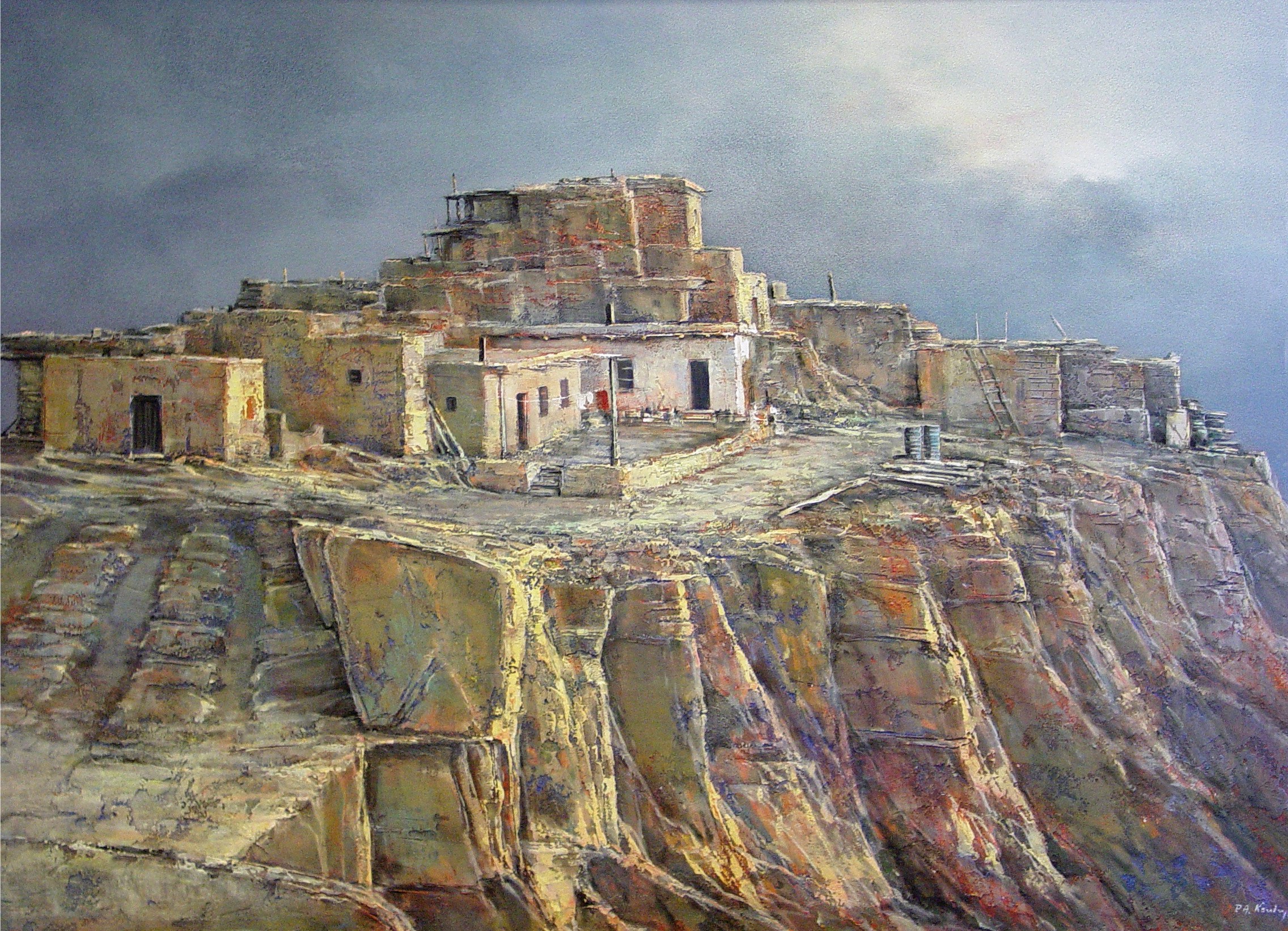
Walpi Pueblo, ca. 1975, marble dust and oil glazes on Masonite. During the 1960s and 1970s Kontny often painted the Hopi villages that were less commercialized and overrun with tourists than the pueblos in New Mexico. The arid and relatively remote location of the Hopi villages overlooking the surrounding valley floor from their high mesas gives them a certain feeling of detachment and otherworldliness to which Kontny’s independent spirit responded. Almost a century earlier William Henry Jackson (1843–1942) photographed Walpi Pueblo.
Denver Drew Him In
From a personal standpoint, Kontny felt that the Mile High City was a great place to raise children because at that time it was not overcrowded, making it easy to get around. The city offered a relaxed lifestyle, clean air, and a scenic location at the base of the Rocky Mountains. They reminded Kontny of the Bavarian Alps which he loved. The prospect of relocating to Denver also appealed to his unflagging sense of adventure. At thirty-seven he felt he could still make a fresh start and re-establish his career outside Europe where he had enjoyed a good deal of commercial success during the previous decade. Denver also offered him a direct connection with the Old West and its Native American population.
By the end of their Denver summer visit in 1960 the Kontnys decided to permanently settle in the Mile High City. Returning to Nuremberg, they gave away their furniture, said goodbye to their friends and prepared to relocate to Denver with their two young children. A home in Cherry Hills, which they had purchased in 1960, became their permanent home in 1962. During their first year in the Mile High City, the whole family was caught up in the excitement of its new American reality. With almost half a million residents, Denver was roughly the size of Nuremberg with amenities like the Denver Art Museum, a good public library system and institutions of higher learning. The Kontnys’ home on South Downing Street in Cherry Hills had a pleasant rural aspect. Paul’s son Mario remembered that “our neighbors had a mini farm with donkeys, chickens and goats.” The Cherry Hills location proved to be a mixed blessing for Paul. While its peacefulness allowed him to work very productively, at times he found himself rather isolated. Unlike his life in Nuremberg, he could not simply walk to his favorite bookstore or take a tram to his gallery. He and his family soon found that they needed a set of wheels just to do grocery shopping and otherwise get around town. Irmgard quickly became the family chauffeur because Paul never learned to drive: he felt it would take away too much time from his painting. In addition to single handedly running the family household, Irmgard did all the shopping, picked up paint supplies from Meininger’s Art Store in downtown Denver, and saw to it that the children did not disturb their father. An indispensable helpmate and unsung hero, she played a crucial role in facilitating Paul’s American career by giving him the luxury of being totally free to paint.
Kontny originally was not slated to become a painter or destined to live in Colorado. The youngest of three brothers in a family of five children growing up in Siemianowice Śląskie (Laurahütte), he enjoyed playing cowboys and Indians with his neighborhood friends that perked his initial interest in Native Americans. His father, a prosperous bakery-cafe owner, wanted him to take over the family business but he harbored artistic aspirations. His father soon recognized them, however reluctantly, and arranged private art instruction for his son; but otherwise Paul remained a self-taught artist. In 1936 his father financed a trip for him to Dresden that provided firsthand contact with masterpieces of European art in the Old Masters Picture Gallery and the Cabinet of Prints and Drawings at the baroque Zwinger Palace. On a side trip to the Karl May Museum in Radebeul near Dresden, Paul enjoyed seeing Native American artifacts at the Villa Bärenfaet (Bear Fat) where he met its first curator, Patty Frank (Ernst Tobis), whose reminiscences brought to life for him May’s stories about Native Americans. On his way home Paul stopped at the Silesian Fine Arts Museum in Breslau (now Wrocław, Poland) to see a number of examples of German Expressionist modern art which later influenced his own creativity after World War II in Europe and Colorado.
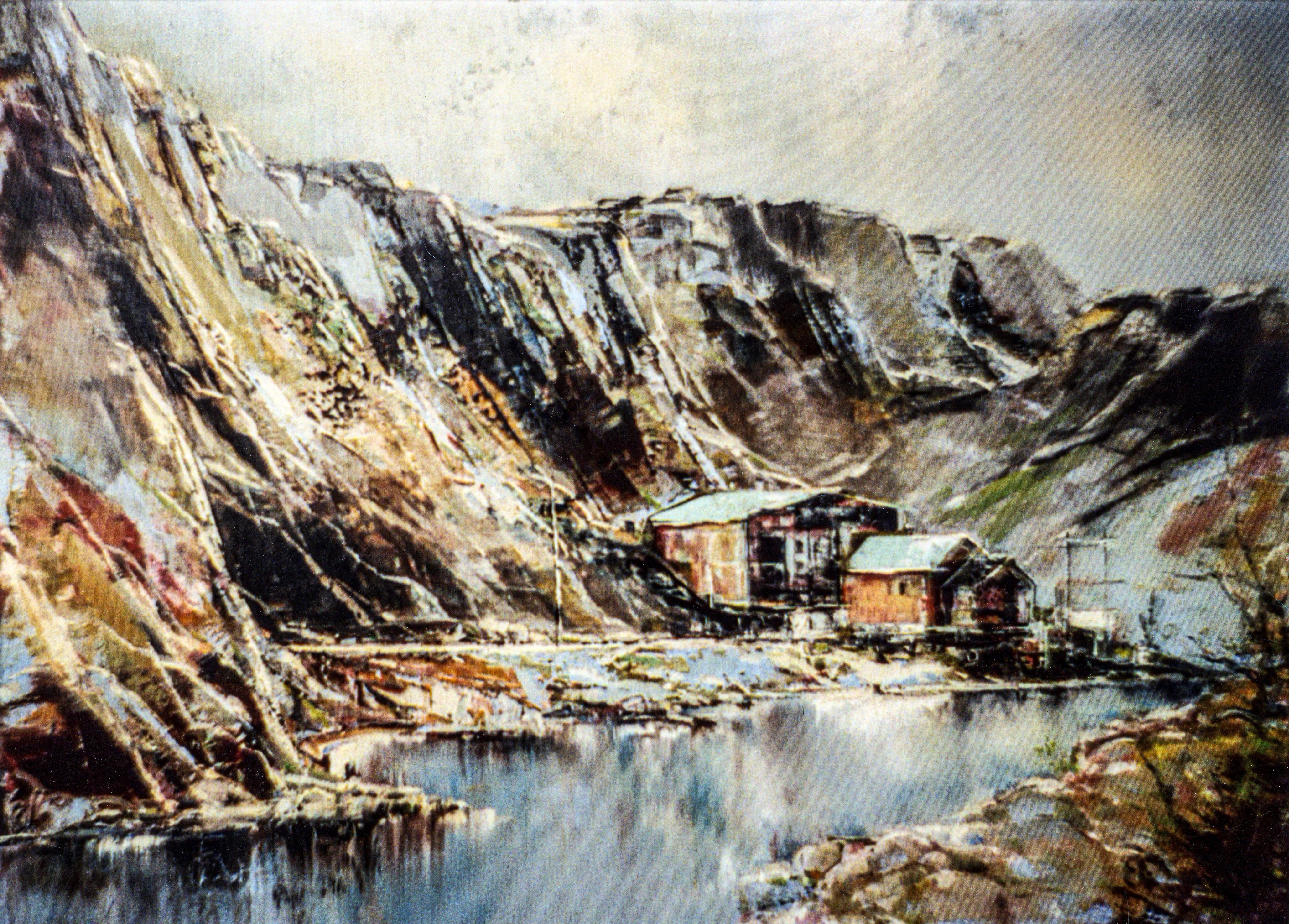
Near Idaho Springs, 1963, oil on canvas. The painting is one of Kontny’s early efforts in his Colorado mining-town genre.
The concern of Paul’s parents about his ability to support himself as an artist led him to begin studying architecture at the Technical College in Breslau (since 1945 the Wrocław University of Science and Technology) in 1940. (Government authorities had closed the Breslau Art Academy, his first choice, eight years earlier.) His studies were cut short in 1941 when he became a reluctant draftee in the German army and served for most of the war as a “Landser”, a G.I., or a common soldier. Although he believed war to be a senseless undertaking, he knew that the Nazi authorities could execute him or send him to a concentration camp for refusing to serve in the army. He shared the opinion of Henry Mielert, also a draftee serving on the Eastern Front and quoted in Stephen Fritz’s book Frontsoldaten (Front Line Soldiers): “War is not an experience, but only a frightful fact that one must endure.”
Kontny spent several years on the Eastern Front in Russia and Ukraine where he came into direct contact with different ethnic groups and their colorful national cultures. The architecture, music, landscapes, and the people themselves made a lasting impression on him and provided his first plein-air experience as an aspiring artist that he continued to draw on in the western United States. During lulls in combat he made a number of small watercolors, drawings and sketches which he kept in his gas mask container until he could send them via the military post to his parents in Gleiwitz (Gliwice). Years later in Denver he painted images from memory of the Russian landscape and pastel portraits of the Cossacks whom he met in southern Russia.
Unlike many of his fellow soldiers on the Eastern Front who regarded the region’s populations as subhuman, inferior people, Kontny came from a home environment that countered the Nazis’ biological racism by counseling him to always be tolerant and respectful of other people’s traditions and religious beliefs. Consequently, Kontny never felt animosity toward the Russians and Ukrainians he encountered because throughout the war he heeded his parents’ advice to never confuse the people of a country with the politics of the country. It became one of the guiding principles of his life which he later applied to the Native American communities he painted in New Mexico, Arizona, Wyoming and Montana.
Historically valuable as an eyewitness record, his wartime drawings and watercolors are conceptually and stylistically different from the propagandistic work of well-known Nazi war artists glorifying the defense of the Fatherland by German soldiers whose chiseled features identified them as members of the Aryan master race. Opposed to war, Kontny consciously avoided popular, stock-in-trade war subjects such as forward troop advances, lightning air attacks and fierce tank battles. He never intended his drawings and watercolors to serve the Nazi ideology, but instead considered them a personal response to his wartime experiences as a private in the
German Army on the Eastern Front. His art also became for him a much-needed psychological counterbalance to the destruction, wanton cruelty, and horrible slaughter he saw committed by both sides in Russia and Ukraine.
Released from internment in southern Germany after the war, he was one of several architects without any Nazi Party affiliations who were enlisted to help construct new headquarters near Nuremberg for the American military newspaper, Stars and Stripes. Thereafter, he joined the Union of Nuremberg Architects, helping to rebuild the city’s districts that had suffered wartime bombing.
In Nuremberg he established his professional career as an artist through exhibitions at the Fränkischer Galerie am Marientor (Franconian Gallery in Mary’s Gate), Bibliothèque Française and the Albrecht Dürer Verein (Albrecht Dürer Society), and through purchases of his works by private collectors and public institutions. In 1955 in Nuremberg Kontny married his wife of forty-seven years, Irmgard Laurer, a ballerina from the Nuremberg Opera and started his family. In addition to the subject of war-torn Nuremberg and its recovery, he painted people and landscapes from Italy, France, North Africa, England, Scotland and Wales based on his trips there in the 1950s. His travels afforded him the opportunity to visit the leading museums in these countries where he saw and studied firsthand world-famous art masterpieces. In the 1950s he began exhibiting throughout Germany—in Munich, Düsseldorf and Essen—as well as in Switzerland. His talent merited his inclusion in Karl Gustav Gerold’s book Deutsche Malerei Unserer Zeit (German Painters of Our Time), published in 1956 by the Verlag Kurt Desch in Munich and Vienna.
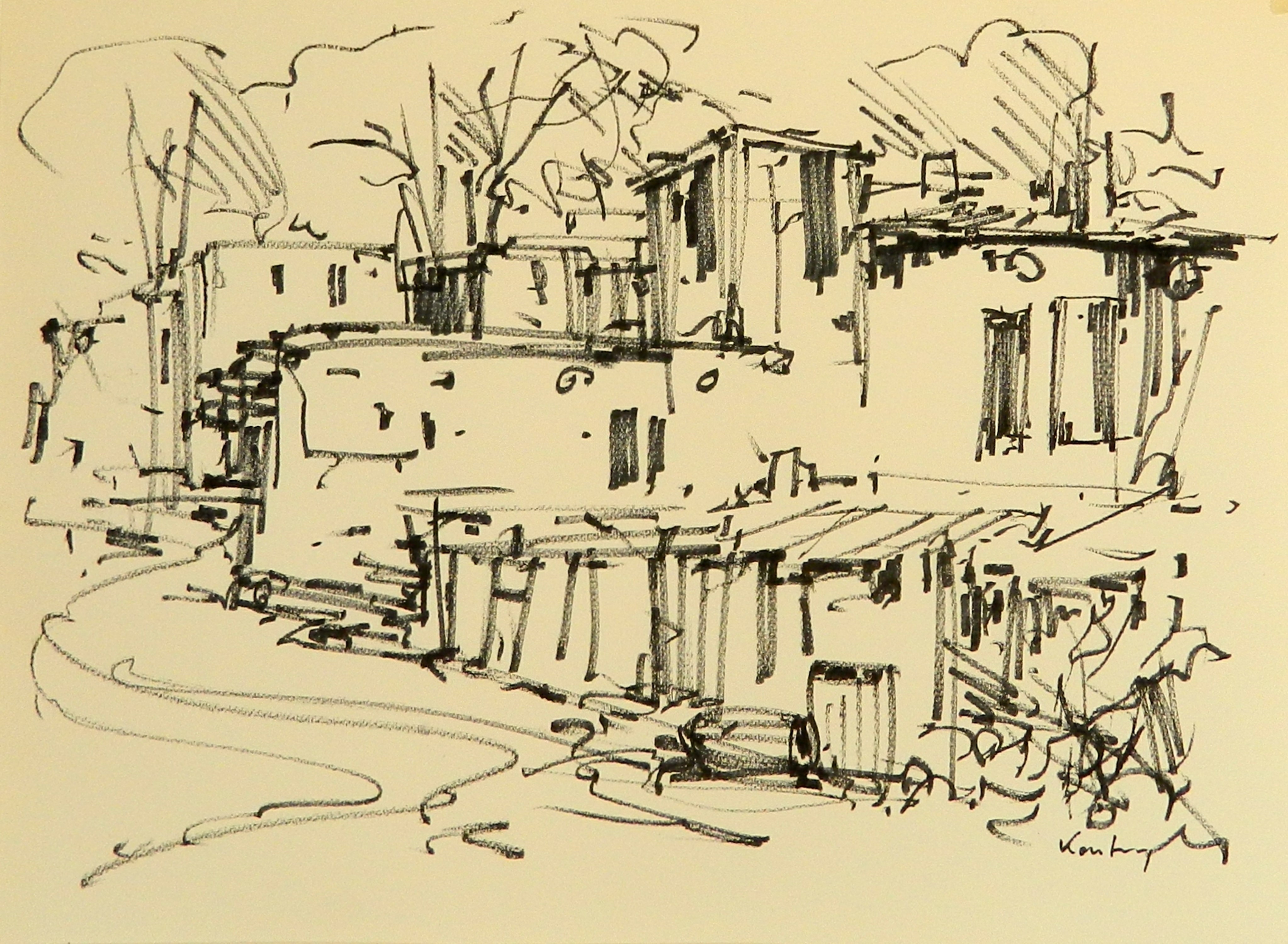
Taos Pueblo, New Mexico, 1964, pen and ink drawing on paper. One of the longest continually inhabited communities in the United States designated a UNESCO World Heritage Site, Kontny’s drawing was part of a large portfolio which he presented to Alice Gibson at her mother’s home La Jacona near Los Alamos in New Mexico in 1964 with a dedication in German, Dem gastlichen Haus von dem 4 Kontnys August 1964 (To a hospitable home from the four Kontnys, August 1964).
In Denver in 1962 Kontny entered into an exclusive contract with Lemon Saks, owner of the Saks Galleries, to whom he had been introduced by John Pogzeba. Their professional relationship lasted a decade and proved mutually advantageous. Together with Hungarian-born Roland Detre (1903–2001), and Austrian-born Herbert Bayer (1900–1985), Kontny was one of only a few contemporary European artists living in Colorado at the time. He came with an established track record of solo shows in Germany, Switzerland and New York, positive reviews, and public and private collections to his credit, all of which assisted Saks in marketing his work in the western United States. Saks immediately recognized Kontny’s talent, “There are only a few people I’ve met in my life who have been true artists” he said. “Kontny is one of them… He is always making himself a better picture. He is never satisfied.” With equal facility in different media, he could paint diverse subject matter—human figures, still lifes, urban scenes and landscapes in both representational and abstract styles. His well-crafted work had a recognizable modern look with potentially wide appeal.
Southwestern Sketches
Although the paintings and works on paper which Kontny produced during his first six months in Denver resulted in a sellout show at Saks’ Denver Art Galleries in September 1962, he was temporarily overcome by frustration stemming from his lack of proficiency in English, the attendant difficulties inherent in acculturation, and the requirements of an exclusive gallery contract which he had not experienced in Europe.
It resulted in a dramatic self-portrait infused with his restless spirit. It epitomizes what he was striving for in his work: a fusion of the representational with the abstract. His likeness emerges out of a mass of frenetic black lines further defined with the same reds, whites and golds. His penetrating eyes, arrested for a moment, take stock of his life up to that point and contemplate his future as a creative individual. The image is stylistically rooted in the German Expressionism that sought to penetrate appearances to lay bare what the artist perceived to be the inner essence of his subject.
For much of the 1960s Kontny and his family spent each summer at the palatial estate of La Jacona northwest of Santa Fe owned by Marjorie Loughridge Williams (grandmother of Denver artist Leon Loughridge) whom Paul met through Lemon Saks. She took the Kontnys to Taos Pueblo and Bandelier National Monument whose sheer-walled canyons impressed Paul. His plein-air pen and ink studies later served as references for the paintings he did in his Denver studio. His hostess also drove Paul and Irmgard west of Albuquerque on the old Route 66 (now Highway 40) to Acoma Pueblo. Its scenic location atop a huge sandstone mesa rising more than 350 feet above the surrounding valley floor studded with sacred, towering monoliths resulted in his referentially abstract image of the Pueblo. It depicts the rugged massiveness and layered structure of the mesa and the walls of the pueblo building and the twin steeples of San Estévan del Rey situated atop it. The painting was included in Kontny’s solo show at the Saks Galleries in Denver in 1964.
Aided by sketches, snapshots and on-site impressions, Kontny painted Taos and Acoma Pueblos–and those on the Hopi Reservation in northern Arizona a decade later–using his trademark technique of marble dust and oil glazes which he had started using in Nuremberg in the 1950s and perfected in Denver. Because of the sheer weight of his paintings in that medium, after some initial experimentation they were done on Masonite panels instead of the traditional canvas he first used. He prepared the marble dust by breaking into a powder pieces of good grade marble which he bought from Marble, Colorado. Using his wife’s old pantyhose, he sifted the dust into fine, medium, and coarse grades. He then primed the rough side of a heavy, tempered Masonite panel with two coats of gesso mixed with the marble dust. He achieved a three-dimensional effect within the spatial dimensions of a two-dimensional Masonite panel by sculpting the various shapes of his image and enhancing them with glazes of fine-grade oil paint.
In addition to the Pueblos, he was intrigued by the small Hispano towns and villages through which he passed during his working vacations in northern New Mexico. The historical connection of the Penitente moradas he saw on location there and in southern Colorado later occasioned his painting, Penitentes. It depicts the Holy Week Good Friday procession of the lay brotherhood that evolved about two hundred years ago to fill the clerical leadership vacuum in the Hispano villages of northern New Mexico and southern Colorado.
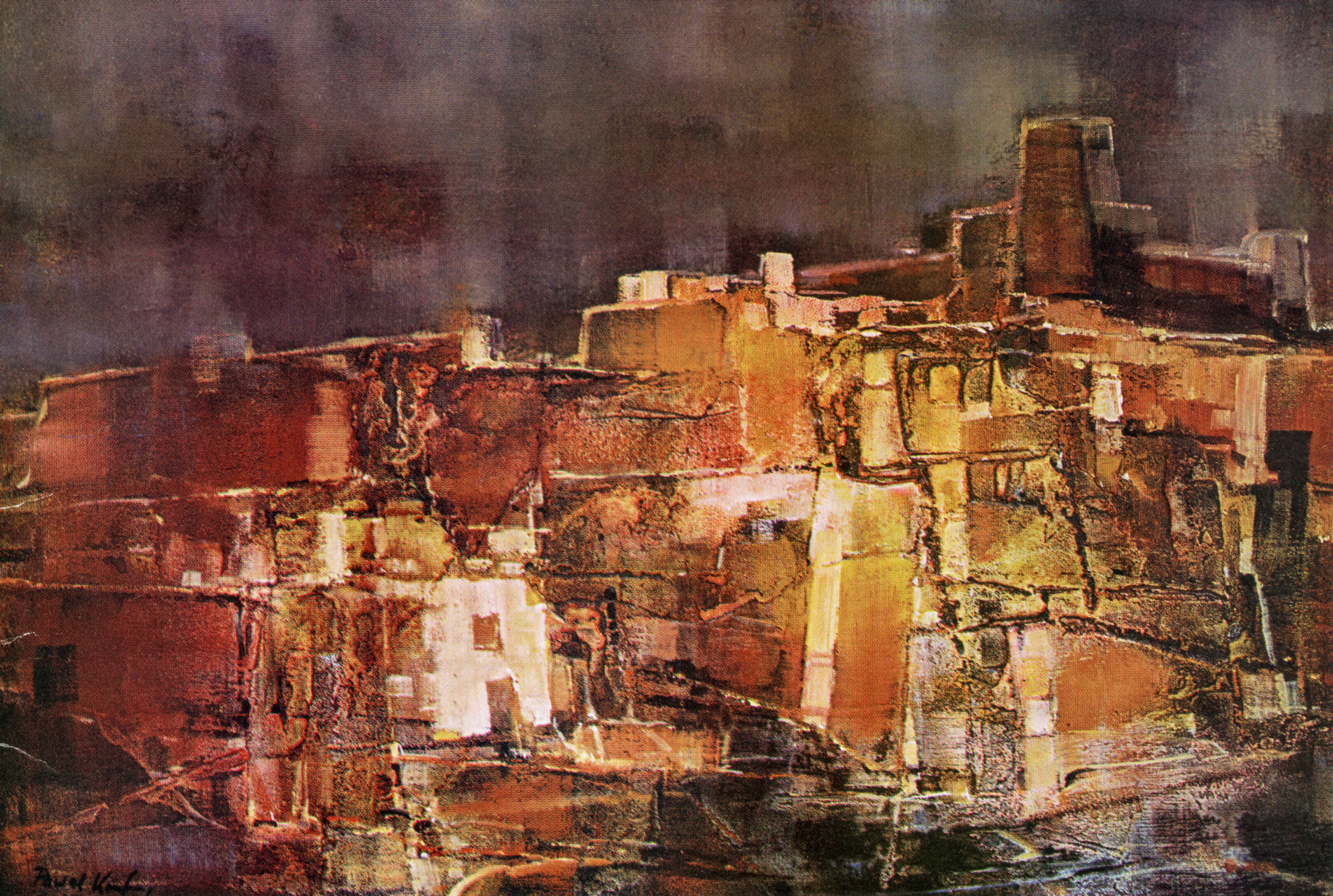
Acoma Pueblo, 1963/64, marble dust and oil glazes on Masonite. The sculpted marble dust forms replicate the rugged massiveness and layered structure of the mesa and the pueblo building situated atop it. The painting was included in Kontny’s solo show at the Saks Galleries in Denver in 1964.
By the mid-1960s when the Kontnys acquired their first car, Paul began another genre that resulted from family day trips to the ghost towns and old mountain mining towns west of Idaho Springs, and Cripple Creek and Victor (Goldfield) near Colorado Springs. They endlessly fascinated him and augmented his boyhood image of the American West. For him, as for the previous generation of artists from Denver such as Vance Kirkland and Elisabeth Spalding and a number from the Broadmoor Academy in Colorado Springs, the state’s old mining towns provided fresh subject matter and a welcome break from the nineteenth-century panoramic landscape tradition still then much a part of Colorado’s art tradition. The mining towns also represented America’s heroic past, offering new opportunities for interpretation beyond the still-popular cowboy-and-Indian myth, which by the mid-twentieth century had become overworked and stereotyped.
The Kontnys’ visit to an old gold mine in Clear Creek County with a retired Cornish miner from England as their guide inspired Paul’s large pure abstraction in marble dust with oil glazes. Its palette and thickly sculpted surface convey the color and texture of a mine’s interior walls. He also painted the old Stanley Gold Mine along Clear Creek between Idaho Springs and the small town of Empire. Partially fusing the mine buildings with the surrounding rugged mountains, he emphasized the harshness of the practically treeless, snowy locale with a thick layer of oil paint sculpted with a palette knife, a technique previously seen in the Bavarian alpine landscapes he did in Europe in the late 1940s.
Several years after painting in the Idaho Springs area, Kontny and his wife happened upon the old gold mining towns of Cripple Creek, Victor, and Goldfield near Colorado Springs by taking a wrong turn on the way to Seven Falls near the Broadmoor Hotel. Cripple Creek, which witnessed the state’s last mining bonanza in nineteenth-century Colorado, had become a shadow of its former self by the late 1960s, as conveyed in Kontny’s watercolors of an old mine with its deteriorating small rail line and mounds of mine dump material, waste rock or mill tailings. In addition to showing abandoned buildings, he produced some images of still-inhabited homes in the mining towns he periodically visited, such as Old Miner’s House, Colorado. Situated peacefully near its water supply, the building shows its age, having been expanded over the years to meet its residents’ needs.
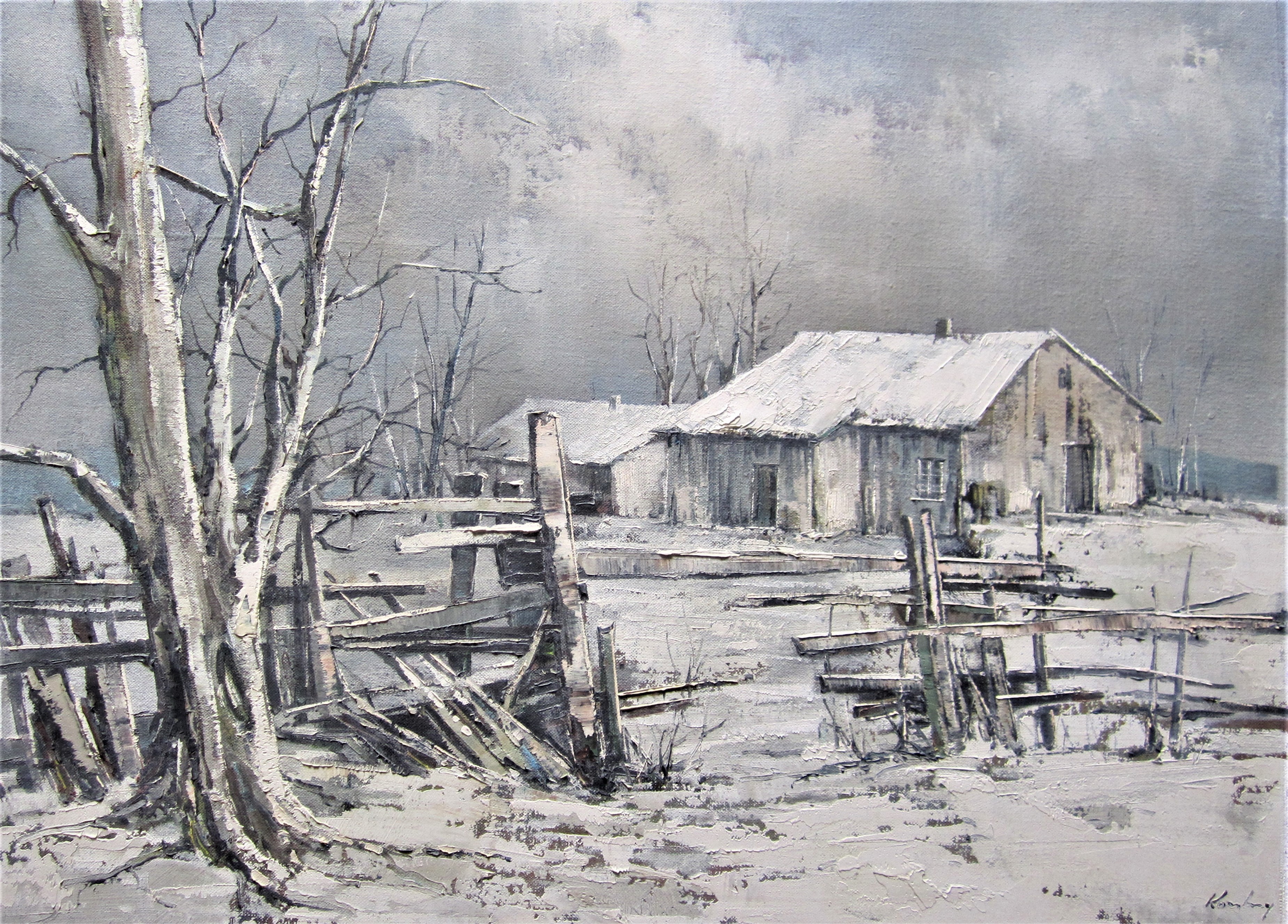
Wyoming Winter Landscape, 1968, oil on artist’s board. Kontny translated the impressions of Wyoming he gathered during his summer trip in a winter landscape painted without the aid of any preparatory sketches or photographs. In creating the crisp, bleak atmosphere, he drew on his experiences in Russia during World War II. The abandoned ranch buildings represented for him another vestige of the Old West that he also depicted during the same period in his abandoned mines and Colorado ghost towns.
The liberating exuberance of Colorado’s sunny expanses and Kontny’s initial enthusiasm over making a new life for himself and his family also released a burst of creative energy in the sculpture medium which he first took up in Europe because it presented an alternative to painting and drawing. He also liked the physical aspect of working in clay and the three-dimensional results it yielded. Monolith was one of his earliest and largest Denver sculptures. The piece represents Paul’s metamorphosis between the European and American continents, dramatically separated by a gulf. The textured left side symbolizes overcrowded Europe burdened with the weight of history and tradition, while the shape of the right side stands for the Rocky Mountains in Colorado. Its smooth surface represents a tabula rasa, a blank slate awaiting the inscription of his American output. He likewise used pastels on linen to record his initial encounter with a Colorado farmstead on the plains.
In the late 1960s Kontny also started painting the Northern Plains Indians. Not content just to work in his studio, Kontny had firsthand contact with the Crow and Blackfoot tribes on a family motor trip in the summer of 1968 to Jackson Hole, Wyoming, and Yellowstone National Park, also stopping at the Buffalo Bill Historical Center in Cody, Wyoming, and the Crow Indian Reservation in southern Montana. At the Center, Kontny viewed paintings and sculptures depicting life in the Old West and intently studied the exhibits of feather headdresses and elaborately beaded costumes worn by the Sioux, Blackfoot and Crow tribes. He observed traditional Crow and Blackfoot dances that brought to life his vicarious boyhood adventures from the pages of Karl May’s novels. He quickly got caught up in the drumbeats that signaled the movements and steps of the richly costumed dancers. The Crow, Blackfoot and Sioux people he saw on that trip provided an abundant source of material for a series of pastel and charcoal portraits. Dating from his visit to the Crow Reservation in 1968 is a
striking charcoal drawing of a young Crow man wearing a horned headdress and caught up in the emotion of his performance as a buffalo dancer. His Denver dealer, Lemon Saks, encouraged him to paint Native American subjects because they were part of the lore of the Old West and were sought by Denver collectors. Kontny conscientiously documented the Indians whom he felt had been largely marginalized by American society and specifically avoided historical recreations in the style of Frederic Remington, Charles Russell, and other painters of western American subjects who became popular after a generation or two.
Within a decade of relocating to Denver, Kontny established himself on the local art scene. Generous by nature, he wanted to give back to the country that had welcomed him and became his new home. Appreciating and seeking to develop young talent, he offered free private drawing classes at his home for several years to aspiring artists who he felt could benefit from his professional training and advice. Attracting between ten and fifteen participants, each class always included a nude model for life drawing. He often paid for the model and did not ask students to contribute if he knew they could not afford it. He also set up easels and provided paper and charcoal. The bottom line for Paul was their talent and willingness to work hard. He told his students that they each needed a good eye to study the subject matter and then to translate it onto canvas or paper. He constantly stressed, “Art is not representation, it is interpretation.” Because he was largely self-taught and felt that “most of my art has come out of myself,” he preferred honest work that emerged naturally from his students. He often told them that a painting derived its strength not just from its composition and execution, but also because it had something to say. Kontny’s greatest gift to his students was instilling the ability to believe in themselves because he recognized and nurtured their talent. A number of those who attended his classes later enjoyed successful careers as professional artists.
For several of the sculptors in the group, Kontny convinced one of his collectors, Werner Livingston–the developer of the Windsor Gardens retirement community in Denver–to provide each of them a monthly stipend for a year and pay the cost of their materials. Peschel Publications in Boulder produced individual, illustrated catalogs of the participants’ sculptures with a short introductory essay by John Jellico, the Denver-based contributing editor of American Artist magazine. Winter Prather provided photographs of the student sculptors’ pieces and Kontny marketed their work to his Denver collectors. Despite the program’s relatively short duration, the participating students got a welcome start early on in their careers because the program underwrote the expensive bronze casting process.
Kontny’s reputation as an artist secured him the commission to paint Governor Richard D. Lamm’s official portrait in 1976 for the Colorado State Capitol rotunda.
During several portrait sittings he shared with the governor his wartime experiences during Operation Blue on the Eastern Front in Russia. Lamm remembered Kontny as “an endlessly fascinating individual.” The likeness was almost completed in time for the official unveiling, but Kontny quickly transformed the governor into a Native American for a collector who wanted to purchase a painting of an American Indian. For the ceremony to which printed invitations had been issued Kontny provided one of his handsomely framed preparatory drawings of the governor. After the event he produced the governor’s portrait showing him seated at a table with a vase of flowers on it. Despite the delay, Lamm liked the result because it captured his personality and avoided the stiff formality of so many official images.
The remarkable scientific achievement of the American moon landing on July 20, 1969, witnessed on television by millions throughout the world, fired Kontny’s imagination and initiated an entire series of remarkable marble dust paintings of the cosmos. He had not started with the intention of creating a predefined series. But he became increasingly engrossed in the subject, pursuing it during the last thirty years of his life up until just a few months before his death in June 2002. He expanded his knowledge by reading Carl Sagan’s books on the cosmos and those of English physicist Stephen Hawking, who researched and wrote about black holes in space. Kontny found the cosmos an absorbing subject because he “saw the cosmic connection as an enlargement of the human spirit.” His Cosmic paintings do not literally recreate the moon’s surface as recorded in the 1960s by America’s five Lunar Orbiter missions. Instead, their sculpted craters simulating those found on the moon serve to anchor and diversify the paintings’ underlying grid-like structure that emanates from Kontny’s early training as an architect. The circles of varying sizes that he carved into the marble dust create diversity and surface movement.
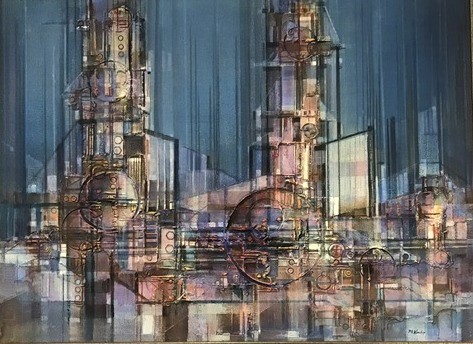
Age of Technology, 1984, marble dust and oil glazes on Masonite. Its structure and palette reference power stations, oil refineries and gas plants in the West as Kontny’s source of inspiration. The concentric circles or bubbles suspended on the surface create another dimension and a feeling of movement, while also serving as subtle focal points for the tall towers above them.
Kontny’s fascination with the cosmos evolved into his Age of Technology series which he fully developed in the 1980s. Primarily abstract in style, it consists of marble dust compositions with masses of sculpted and incised circles and lines. These intricately wrought shapes allude to the sleek modern buildings, natural gas plants and oil refineries that he saw during his travels in Colorado and elsewhere in the western United States. The entire series symbolizes his admiration of modern technological achievement. Like his Cosmos series, the Age of Technology and its successor series, Monuments of Antiquity, provided a respite from the representational work for which he had established a solid reputation in Denver and the West.
Kontny always maintained a generosity of spirit. He often gifted paintings and drawings to friends simply because they appreciated his creative output. Similarly, without expecting anything in return, he repeatedly donated his work to support charitable causes in Denver such as Opera Colorado, the Denver Center for the Performing Arts, the Denver Symphony Orchestra, Colorado Academy, the Cancer League of Colorado, the Colorado AIDS Project, the Sisterhood of Temple Emanuel, Mount Saint Vincent Home, the Carousel Ball of the Children’s Diabetes Foundation and the KRMA Channel 6 Auction.
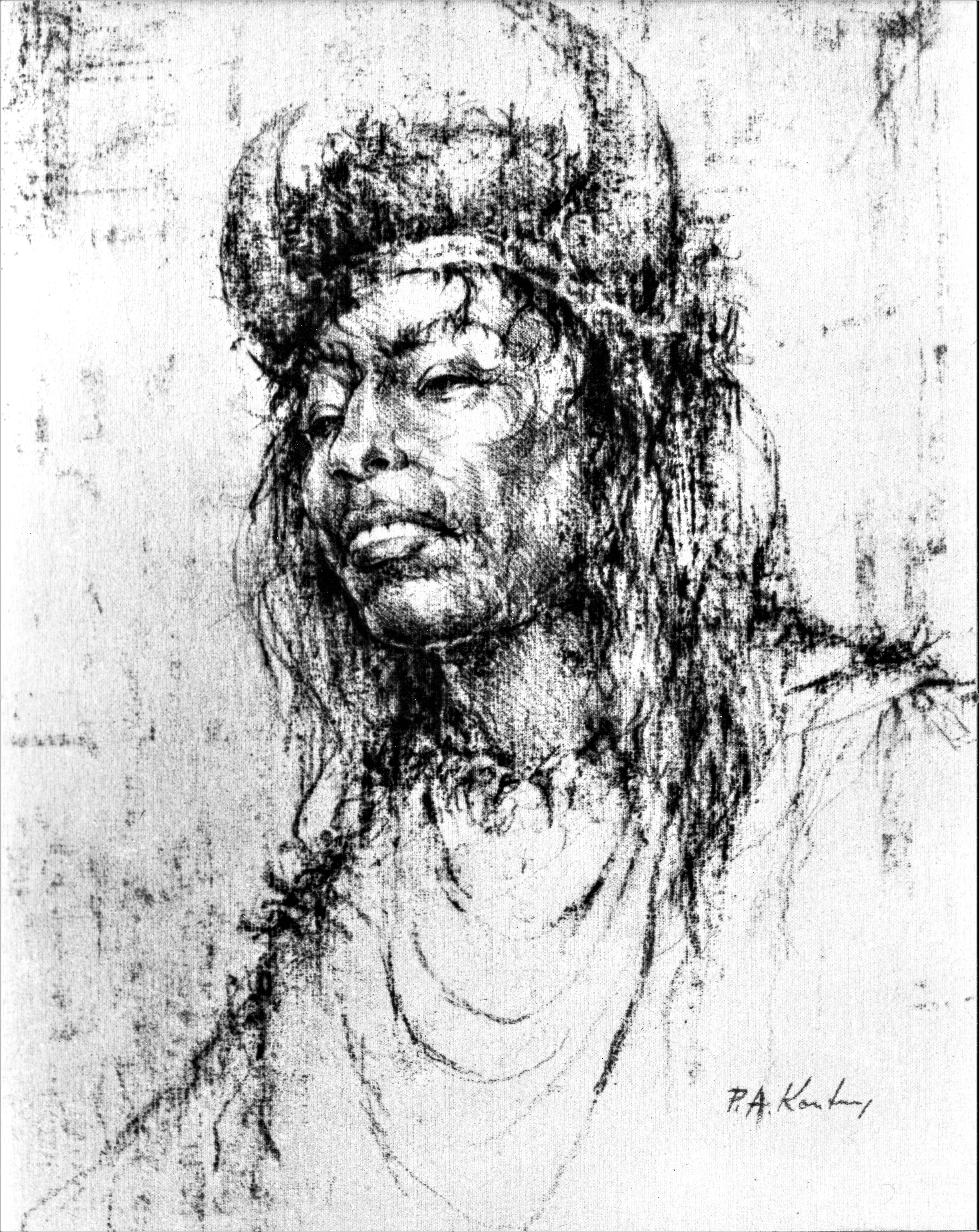
Crow Indian Buffalo Dancer, 1968, charcoal on artist’s board. Kontny had firsthand contact with the Crow and Blackfoot tribes on a family motor trip in the summer of 1968 that included stops at the Buffalo Bill Historical Center in Cody, Wyoming, and the Crow Indian Reservation in southern Montana.
Painting Against the Clock
During the last years of his life Kontny experienced the onset of macular degeneration. He nevertheless persisted in executing his last series of marble dust paintings of the cosmos, masterfully painted out of the corner of his eye. Despite his rapidly failing eyesight after the year 2000, he did a number of Conté crayon drawings with interlocking forms. One of them documents his own physical condition. Its tortured expression, with only one eye visible, externalizes the frustration at his advancing macular degeneration—a tragedy for any creative individual—as well as the physical pain he increasingly felt. One of his last photographs, taken by Paul Mitchell, shows him wearing an American Indian headdress which he had received from one of the tribes in 1975 as a gift for his creative output devoted to Native Americans.
Nearly blind by 2001, he was diagnosed that August with leukemia, which spread throughout his system and considerably worsened his health. Chemotherapy left him weak but also produced kidney stones and painful spine spurs. Paul Kontny passed away on June 26, 2002. Several months later his widow, accompanied by their children and grandchildren, scattered his ashes to the wind in the mountains above Vail, Colorado. In the tradition of the Native American and Asian cultures that interested him throughout his life, he wanted to return to nature and the cosmos where he believed he ultimately belonged.
Employing representational, referentially abstract and totally abstract styles with equal facility in his two successful careers in West Germany and Colorado, Kontny sketched, painted and sculpted the landscape, the human figure, urban and rural scenes and the cosmos. The variety of subject matter and styles makes it hard to believe that the same hand created them all. At times his diversity complicated the marketing of his work. Galleries and collectors could not always easily categorize his work into periods along a neat, developmental timeline, because he simultaneously explored different subjects to avoid boredom and premature artistic burnout.
The strength and vitality of his work reflect his passion for life and the inspiration constantly provided by his immediate environment. Happy to have escaped death during World War II, he relished the opportunity to paint and sculpt those subjects that fascinated him. Although valuing nature, he avoided imitating it; instead, he took images from the visual world and recast them in his artist’s mind. He was constantly brimming with ideas which he eagerly worked out and committed to canvas and paper. For the second half of his life, he was based in Denver where Colorado and the Southwest offered him a wide range of seemingly inexhaustible subject matter embracing the region’s nineteenth-century mining heritage, its Native American and Hispano residents, oil refineries and electric plants, all under the expanse of the cosmos. Colorado’s wide-open spaces and the artistic freedom they offered energized his creativity over four decades. The work he produced in a variety of media reflects the vitality of postwar America of which he was a part. Throughout his career he remained very focused on his art, always knowing that he had many more ideas than he could ever realize in a single lifetime.
